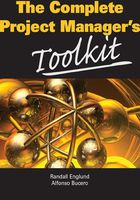
PREFACE
The Complete Project Manager integrates key technical, people, business, and organizational skills. This companion to the core book offers related tools, checklists, tables, and examples.
The core book establishes the premise that success in any environment largely depends on completing successful projects, and successful projects get done by skilled project managers and teams, supported by effective project sponsors. It is the integration across a spectrum of skills that enables certain individuals to make a difference and achieve more optimized outcomes. The ultimate aim of this book is to put action-oriented tools into your hands, allowing you to develop a complete set of skills that is the right set for you to excel in today’s competitive environment. The goal is to equip you and your colleagues to be leaders and managers in the project environment … and beyond.
INTENDED AUDIENCES
As with the core book, the primary audience is project, program, and portfolio managers, in all disciplines and industries, commercial, nonprofit, and government. You may be new to the profession and be seeking a primer to get started in the right direction. You may have a few years of experience and want to get on a fast track. You may have lots of experience but have come to realize that a fresh start and changed thinking are on the agenda, perhaps triggered by layoffs, job changes, or other transitions. This audience is huge—note that there are more than 350,000 members of the Project Management Institute across the globe.
The secondary audience is individual contributors, subject matter experts (SMEs), project team members, managers of project managers, project sponsors, and other executives. They may be new to this role and wonder what they are getting into—how can they better understand the people, roles, and expectations for the people they work with? Or they may be experienced and looking for leading practices that accelerate their performance. This audience is even larger than the number of project managers. We hope your experience with this book prompts you to share it with this extended audience.
PURPOSE AND USES
This Toolkit is designed to put tools in your hands that will help you implement the concepts we cover. The concepts are simple to understand, universal, powerful, and immediately applicable. You may already be aware of what you need to do but, for any number of reasons, you are not doing it. This book supplies the how. It provides checklists, tables, and examples from real people of how to apply the concepts, thereby demonstrating their feasibility. It removes barriers to implementation. These barriers may be environmental, executive, or business-related—anything that has seemed like an obstacle and that has delayed projects, caused cost overruns, lowered quality, or caused deliverables to not meet requirements. These barriers existed because people were not aligned and motivated to perform. To overcome them, you may just need to see a model for how a task or process can be implemented. The Toolkit and the core book will expose you to implementation aids and show you complete ways to look at your situation and see new solutions or apply old solutions in new ways. The goal is to integrate knowledge and skills that make the difference in achieving optimized outcomes, increased satisfaction, and bottom-line results.
By reading this and the core book, you will discover evidence and examples for implementing a complete systems approach to project leadership. You will learn how soft skills applied to project management, environmental, leadership, negotiating, and persuasive skills can be creatively applied. You can achieve greater results through changed thinking and by using the simple, immediately actionable tools we provide. There is no complicated model to understand before applying the ideas and tools in this book.
The core book and this Toolkit may be used as self-study; they may serve as references that you come back to repeatedly to refresh your thinking or find new insights; they may be used by book clubs to trigger sharing of similar or different experiences; they may be used by universities and training companies in the ever-growing number of courses offered on management and leadership; and they may be used by the authors and other consultants in seminars they facilitate worldwide.
Key objectives we anticipate for readers of this Toolkit are to:
Change your thinking about how to learn and apply necessary skills to enhance on-the-job performance
Apply different approaches to leading and managing projects, based upon examples and checklists
Realize what needs to be done to achieve better results…and how to do it
Further develop professional careers in project or program management.

February 2012